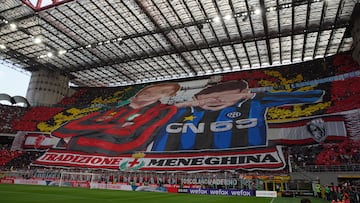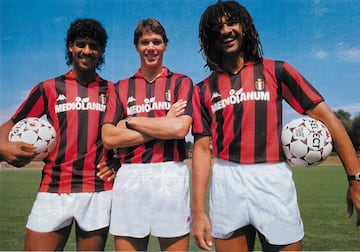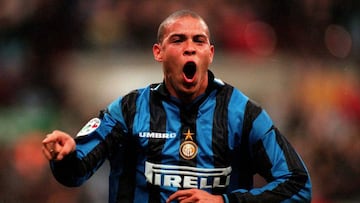CHAMPIONS LEAGUE
AC Milan vs Inter: which Champions League semi-finalist is the bigger club?
Milan and Inter meet in the Champions League last four, with both clubs aiming to reach the trophy decider for the first time in over a decade.

The Champions League semi-final between AC Milan and Inter, which kicks off with the first leg today, will be a true festival of football for the northern Italian city. If measured by the participants’ combined trophy hauls, the century-old rivalry is the biggest there is between two clubs from the same city. Both beaten to the Serie A title this season, with Napoli winning the Scudetto for the first time in 33 years, Inter come into this European Derby della Madonnina in better shape: the Nerazzurri have won Italy’s Supercoppa and reached the final of the Coppa Italia this season, and sit fourth in the league, two points ahead of Milan. However, whoever advances from the Champions League last four will, without doubt, have earned this term’s bragging rights in the Lombardy regional capital.
Who has more domestic silverware?
When it comes to the question of which Milan club is bigger, the most obvious yardstick to turn to is silverware. And in domestic terms, Inter have the upper hand - albeit not by much. They have won 34 trophies in the Italian game, three more than their arch rivals. The clubs are level on 19 Serie A titles and seven Supercoppas; it is the Coppa Italia that separates them. Inter lead 8-5, and could lift the Italian cup for the ninth time this term: Simone Inzaghi’s men face Fiorentina in the trophy decider on 24 May. In domestic terms, Inter are widely considered to be a bigger deal than their neighbours - so much so that the title ‘derbi d’Italia’ is given to their clash with Juventus, who are the country’s most popular club. It’s a view that has much to do with Inter’s deeper history of success; Milan didn’t enjoy their golden age until the 1980s and 90s.
Who has more international trophies?
And it’s down to their illustrious turn-of-the-century period that Milan can justifiably consider themselves the more significant club in the eyes of the wider world. Of the Rossoneri’s seven European titles, five have come since 1989. In this time, Milan have also won all five of their UEFA Super Cups, two of their three Intercontinental Cups and their only Club World Cup. By comparison, and while it’s true that they have also won three UEFA Cups, Inter have ‘only’ three European Cups to their name, two of which were won back in the 60s. It is worth noting, though, that Inter were the most recent Milan club to lift the continent’s most prestigious trophy, in 2010. Since then, neither side has made it back to the Champions League final. In terms of the clubs’ previous meetings in the competition, there have been four: two victories for Milan and two draws.

Which club has more Ballons d’Or?
Milan’s greater international success is largely why their players have received more Ballons d’Or than Inter’s. Since it was introduced in 1957, eight Milanistas have won the accolade. The first, in 1969, was the legendary Gianni Rivera, who was a member of the team that beat Johan Cruyff’s Ajax to secure the club’s second European Cup. During the trophy-laden period that began two decades later, the club’s stars then became Ballon d’Or regulars. Ruud Gullit picked up the award in 1987, before Milan players made up the top three in the voting for the 1988 prize: Marco van Basten, Gullit and Frank Rijkaard. Van Basten repeated his Ballon d’Or success in 1989 and 1992, before George Weah scooped the trophy in 1995. Andriy Shevchenko (2004) and Kaká (2007) also received the gong.
At Inter, the club’s most glorious period was probably the 60s, led by Argentinian coach Helenio Herrera and the Spanish forward Luis Suárez. ‘La Grande Inter’ won the European title on two occasions. It wasn’t until the 21st century, under Roberto Mancini and, above all, José Mourinho, that the Nerazzurri would emulate those feats. In 2009/10, Mourinho steered Inter to their first ever domestic and European treble. When it comes to Ballons d’Or, two Inter players have earned the award: Lothar Matthäus in 1990 and Ronaldo Nazário in 1997. However, Ronaldo chiefly won the accolade for his goalscoring exploits in the 1996/97 season, which he had spent at Barcelona.

Public image
The clubs’ history is a major factor in the image they have in Italy - although the associations born out of their origin story have, over time, been diluted. Inter were founded in 1908, nine years after their rivals, after a breakaway by 44 members of AC Milan, which at the time was known as the Milan Football and Cricket Club. Opposed to Milan’s decision to ban foreign players from turning out for the team, they created Inter, whose name - Football Club Internazionale - reflects their commitment to embracing overseas players. With Milan left as the team of the Italians, and Inter filled with foreigners employed in Italy’s banking sector, their rivalry came to be seen as the club of the local working man vs the club of the country’s moneyed elite. Things have moved on a bit since then, however. Milan are now majority-owned by a billion-dollar American investment firm, while Inter’s financial backing comes from China.
Silvio Berlusconi’s 31-year tenure as Milan president, during which the Rossoneri won 29 trophies, had a major influence on the club’s charisma - but also people’s reservations about it. And Milan became embroiled in a corruption scandal at the start of the 21st century, while Inter, on the other hand, boast of their clean disciplinary record, having never been docked points or condemned to administrative relegation to the second tier. That said, this hasn’t prevented the club’s reputation from being blemished by the odd shady affair here and there.
Fans and finances
In terms of the clubs’ financial muscle, Inter boast higher annual revenue (around €334m) and also spend more, leading the newspaper Gazzetta dello Sport to report that the club amassed losses of over €140m last term. Milan bank around €292m a year, but have more balanced books than their neighbours: their latest annual losses are estimated to be around €66m. According to Transfermarkt, the value of Milan’s squad is marginally higher than Inter’s: €547m compared to €534m.
When it comes to season-ticket holders, Milan and Inter have a similar number. Given they share the San Siro stadium, this isn’t surprising. Per football business specialists Calcio e Finanza, the former have 40,000, while the latter have 41,000. The clubs’ average attendances this term are also very closely matched, with Inter’s 72,738 slightly larger than Milan’s 71,854. That said, a range of studies estimate that the Rossoneri’s more recent history of success, and their seven European Cup wins, have helped them earn the higher number of overseas supporters. Today, Inter can take a big step forward in their bid to close the gap on the international stage.






